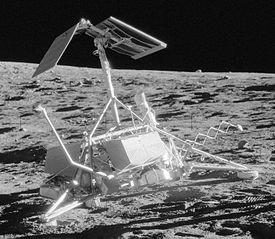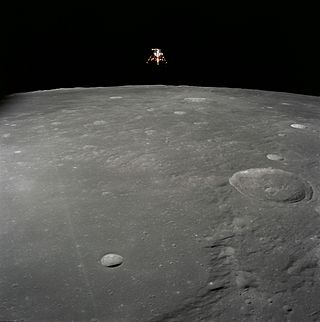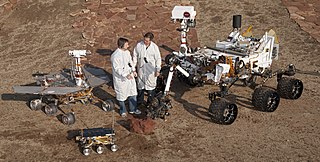| Spacecraft | Organization | Date | Type | Status | Notes | Image | Ref |
|---|
| Chang'e 5 |  CNSA CNSA | 16 December 2020 | sample return | success | Retrieved 1.731 kg of lunar sample and returned it to Earth |  | 2020-087A [3] |
| | Chang'e 5 Lander |  CNSA CNSA | 30 November 2020 - 11 December 2020 | success | Obtained lunar sample and placed on ascent vehicle; conducted radar studies of underground structure |
| | Chang'e 5 Ascent vehicle |  CNSA CNSA | 3 December 2020 - 7 December 2020 | success | Transferred lunar sample onto return capsule via lunar-orbit rendezvous; intentionally deorbited |
| | Chang'e 5 Orbiter |  CNSA CNSA | 9 September 2021 | flyby | success | Extended mission following separation of Chang'e 5 Returner; returned from Sun-Earth L1 [4] to conduct lunar flyby [5] |
| | Chang'e 5 Orbiter |  CNSA CNSA | Late 2021 - | orbiter | in orbit | First spacecraft to utilize Distant Retrograde Orbit (DRO) about Earth-Moon L1 and L2 |
| CAPSTONE |  NASA NASA | 14 November 2022 [6] | orbiter [7] [8] | in orbit | Lunar orbiting CubeSat that will test and verify the calculated orbital stability planned for the Gateway space station. |  | CAPSTONE |
| Artemis 1 Orion MPCV CM-002 |  NASA NASA | 21 November 2022 | flyby | success | Uncrewed test of the Orion spacecraft in lunar flyby and DRO orbit. |  | ARTEMIS-1 [9] |
| 25 November 2022 | orbiter | success |
| 5 December 2022 | flyby | success |
| LunaH-Map |  NASA NASA | 21 November 2022 (flyby) | orbiter | failure | intended to perform engine burn to achieve a lunar orbit to search for evidence of lunar water ice inside permanently shadowed craters using its neutron detector. Orbit insertion failed possibly due to a struck valve. The mission was terminated after six month in solar orbit. |  | LUNAH-MAP [10] [11] |
| Lunar IceCube |  NASA NASA | 21 November 2022 (flyby) | orbiter | failure | intended to perform engine burn to achieve a lunar orbit to use its infrared spectrometer to detect water and organic compounds in the lunar surface and exosphere. |  | L-ICECUBE |
| EQUULEUS |  JAXA JAXA | 21 November 2022 | flyby | success | image the Earth's plasmasphere, impact craters on the Moon's far side and L2 experiments. | | EQUULEUS |
| LunIR |  Lockheed Martin Lockheed Martin | 21 November 2022 | flyby | failure | image surface thermography, failed to observe the Moon due to faulty communication |  | LUNIR [12] |
| NEA Scout |  NASA NASA | 21 November 2022 | flyby | failure | Solar sail intended to flyby a near-Earth asteroid. Communication failure. |  | NEA-SCOUT |
| ArgoMoon |  ASI ASI | 21 November 2022 | flyby | success | image the ICPS and perform deep space Nanotechnology experiments. |  | ARGOMOON |
| OMOTENASHI solid motor and orbiting module |  JAXA JAXA | 21 November 2022 (flyby) | impactor | failure | intentional impact after separation from surface probe. Prepares the trajectory for landing of surface probe. Communication failure, missed target | | OMOTENASH |
| | OMOTENASHI surface probe |  JAXA JAXA | semi-hard lander | failure | inflatable module attempting to land semi-hard at lunar surface. Communication failure, missed target |
| CuSP |  NASA NASA | 21 November 2022 | flyby | success | mission to study particles and magnetic fields. Did lunar flyby due to launch trajectory. |  | CUSP |
| BioSentinel |  NASA NASA | 21 November 2022 | flyby | success | it contains yeast cards that will be rehydrated in space, designed to detect, measure, and compare the effects of deep space radiation. |  | BIOSENTNL |
| Team Miles |  Fluid & Reason Fluid & Reason | 21 November 2022 | flyby | success | demonstrate low-thrust plasma propulsion in deep space. | | TEAMMILES |
Danuri
(Korea Pathfinder Lunar Orbiter) |  KARI / KARI /
 NASA NASA | 16 December 2022 [13] | orbiter | in orbit | Lunar Orbiter by the Korea Aerospace Research Institute (KARI) of South Korea. The orbiter, its science payload and ground control infrastructure are technology demonstrators. The orbiter will also be tasked with surveying lunar resources such as water ice, uranium, helium-3, silicon, and aluminium, and produce a topographic map to help select future lunar landing sites. |  | KPLO |
| Hakuto-R Mission 1 |  ispace ispace | April 2023 | lander | failure [14] | Lunar lander technology demonstration. | | HAKUTO-R1 |
| | Rashid |  UAESA/MBRSC UAESA/MBRSC | April 2023 | rover | | Lunar rover, part of the Emirates Lunar Mission. |  |
| | SORA-Q |  JAXA/Tomy/Doshisha University JAXA/Tomy/Doshisha University | April 2023 | rover | | Lunar rover technology demonstration. | |
| Lunar Flashlight |  NASA NASA | 11 December 2022 (launch) | orbiter | failure [15] [16] | was to enter a near-rectilinear halo orbit; couldn't leave Earth orbit due to propulsion failures. |  | L-FLASHLT |
| JUICE |  ESA ESA | 14 April 2023 (launch) | flyby | en route | will fly by the Moon in August 2024 en route to Jupiter. |  | [17] |
| Chandrayaan-3 |  ISRO ISRO | 14 July 2023 (launch)
5 August 2023 (orbit insertion) | Orbiter | in orbit | bring the lander from Earth parking orbit to pre-landing 100 km (62 mi) lunar orbit and study the spectral and polarimetric measurements of Earth from the lunar orbit. |  | CHANDRYN3 |
| | Vikram |  ISRO ISRO | 23 August 2023 | lander | success | primary objective is to redo Chandrayaan-2 landing which had failed. In-site observation & conducting experiments on the materials available on the lunar surface to better understand composition of the Moon. |
| | Pragyan |  ISRO ISRO | 23 August 2023 | rover | success | stowed inside lander. Demonstrating the rover’s loitering capabilities on the Moon. In-site observation & conducting experiments on the materials available on the lunar surface to better understand composition of the Moon. |
| | Chandrayaan-3 Propulsion Module |  ISRO ISRO | Between 13 October and 10 November 2023 | 4 flybys | success | Extended mission following lunar orbit operations to returning to Earth orbit |
| Luna 25 |  Roscosmos Roscosmos | 10 August 2023 | lander | failure [18] | Launched 10 August 2023, orbit insertion 16 August 2023, crashed on lunar surface on 19 August 2023 following an anomalous orbital lowering maneuver. |  | LUNA-25 |
| SLIM |  JAXA JAXA | 19 January 2024 | gravity assist/lander | success [19] | Successfully demonstrated precision landing by landing within 100 m (330 ft) of its target spot. [20] [21] Its solar cells were initially not generating electricity due to wrong attitude [22] but in ten days the Sun moved enough to temporarily provide power to the spacecraft. [23] |  | SLIM |
| | LEV-1 |  JAXA JAXA | 19 January 2024 | rover | success | Lunar rover with a hopping mechanism. Conducted six hops on lunar surface. [24] | |
| | LEV-2 |  JAXA/Tomy/Doshisha University JAXA/Tomy/Doshisha University | 19 January 2024 | rover | success | Lunar rover, reflight of the SORA-Q rover launched with the failed Hakuto-R Mission 1. Imaged SLIM lander on lunar surface. [25] | |
| Peregrine |  Astrobotic Technology Astrobotic Technology | 8 January 2024 (launch) | lander | failure | Lunar lander selected for NASA's Commercial Lunar Payload Services carrying a total of 25 payloads. Landing abandoned due to excessive propellant leak. [26] |  | PEREGRN-1 |
| | Colmena × 5 |  UNAM UNAM | 8 January 2024 (launch) | rover | failure | Five small robots that will be catapulted onto the lunar surface. Mission phased out along with landing of Peregrine lander due to excessive propellant leak. [27] | |
| | Iris |  CMU CMU | 8 January 2024 (launch) | rover | failure | Lunar rover, will test small, lightweight rover mobility on the Moon, and collect scientific images for geological sciences. Mission phased out along with landing of Peregrine lander due to excessive propellant leak. [28] | |
| IM-1 Odysseus |  Intuitive Machines Intuitive Machines | 22 February 2024 | lander | success | Lunar lander selected for NASA's Commercial Lunar Payload Services carrying a total of 6 payloads. |  | IM-1-NOVA |
| | EagleCam |  Embry–Riddle Aeronautical University Embry–Riddle Aeronautical University | 28 February 2024 | semi-hard lander | failure | Deployable camera designed to attempt to capture the first third-person images of a lunar landing. Ejected post landing due to technical issues, failed to return images. [29] | |
| DRO-A |  CAS CAS | 13 March 2024 (launch) | orbiter | failure | YZ-1S upper stage failed to deliver spacecrafts into correct orbit. The satellites were intended to test Distant retrograde orbit. [30] | | |
| DRO-B | orbiter | failure |
| Queqiao-2 |  CNSA CNSA | 24 March 2024 | orbiter | in orbit | Lunar far side relay satellite. |  | QUEQIAO-2 |
| | Tiandu-1 |  Deep Space Exploration Laboratory Deep Space Exploration Laboratory | orbiter | in orbit | will test communications for future lunar satellite constellation technologies. | |
| | Tiandu-2 | orbiter | in orbit |
| Chang'e 6 |  CNSA CNSA | 3 May 2024 | sample return | enroute | First sample-return from the South Pole–Aitken basin on the far side of the Moon. [31] [32] |  | CHANG-E-6 |
| | Chang'e 6 Lander |  CNSA CNSA | enroute | will obtain lunar sample and placed on ascent vehicle; will conduct radar studies of underground structure |
| | Chang'e 6 Ascent vehicle |  CNSA CNSA | enroute | will Transfer lunar sample onto return capsule via lunar-orbit rendezvous; later intentionally deorbit |
| | ICUBE-Q |  SUPARCO SUPARCO | entroute | Pakistan's first lunar mission. |































